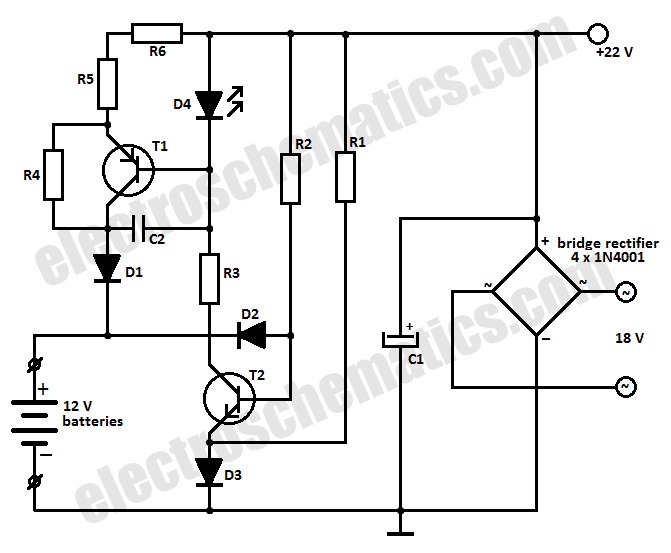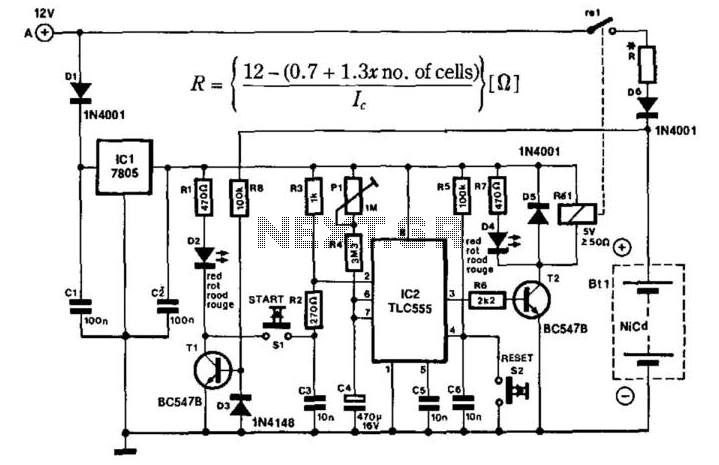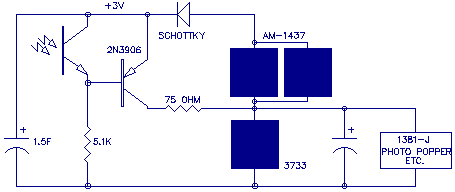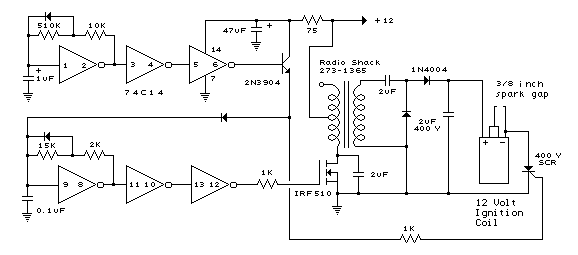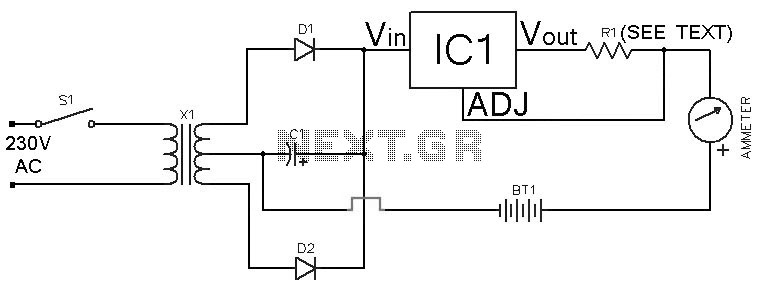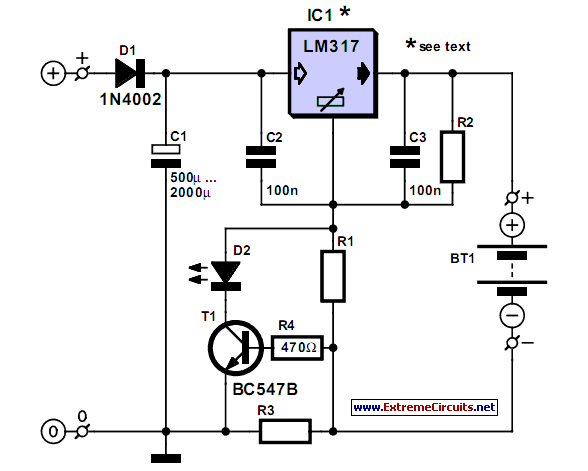
solar charge
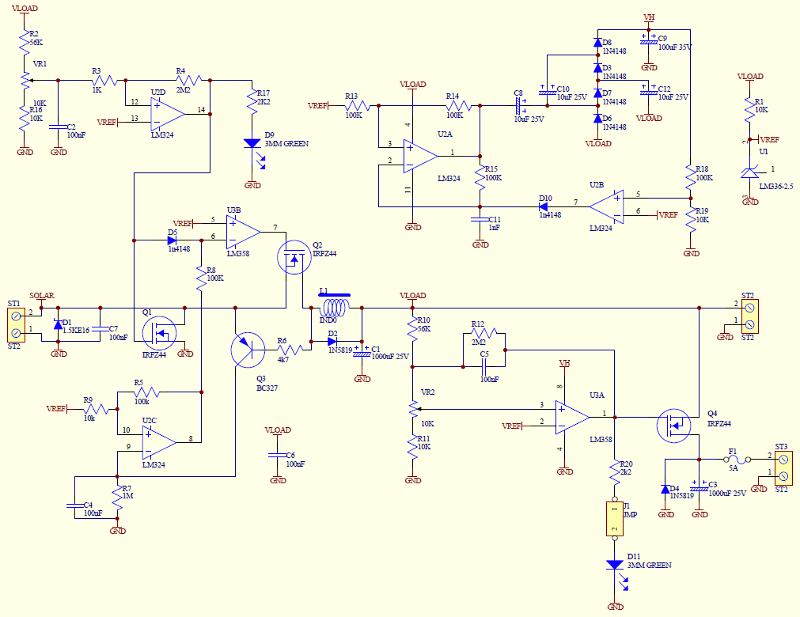
An unconventional, scalable high-efficiency 12V solar power system and battery charge controller with low voltage cutout to protect the battery, ideal for systems of 50W or less. This circuit was designed for small to medium lead-acid systems and features a low idle current (5mA), which increases battery life on small capacity systems. All components in this design are through-hole parts and can be sourced from various suppliers. None of the parts require programming, and only a voltmeter and an adjustable supply are needed to calibrate the board, making it easy and cost-effective to build and maintain. Maximum Power Point Tracking (MPPT) controllers are microprocessor-controlled switch-mode converters that adjust the duty cycle to find the panel voltage corresponding to the maximum power output of the photovoltaic cells, providing the highest conversion efficiency. They dynamically adjust to environmental changes. For example, if the battery is at 11V and the solar panel provides optimum power at 15V, the MPPT would take in 15V at 4A (60W) and output 11V at 4.9A (53.9W), accounting for a 10% conversion loss. A direct connection might only yield 11V at 4.2A (46.2W). While MPPT systems are more complex and require a microprocessor, they offer significant benefits in efficiency. The choice between MPPT and simpler systems often comes down to cost. If a panel costs $3/Watt and an MPPT converter is $35 more than a basic converter, the MPPT must save at least $35 in panel costs to justify the investment. Assuming a 20% performance increase, MPPT converters become more cost-effective at power levels exceeding 58.8W. Typical solar chargers use a Schottky diode to prevent battery drainage into the PV panel and a shunt regulator to short-circuit the panel when the battery is fully charged. However, diode losses can result in heat generation; for example, a 50W 12V panel supplying 4A to the battery may result in a 0.4V drop across the diode, dissipating around 1.6W as heat. This necessitates a heat sink and results in power loss. The circuit described here utilizes a MOSFET instead of a diode, significantly reducing power loss to resistive heating. A 40W PV system using IRFZ48 MOSFETs experiences only about 0.25W loss on Q2, leading to less heat generation and more power available for the battery. The MOSFET configuration eliminates the need for a diode between the solar panel and the load, with Q2 functioning as a reverse MOSFET to ensure current flows from the PV panel to the load. When a significant voltage is present across Q2, Q3 activates, charging capacitor C4, which in turn enables U2c and U3b to switch on MOSFET Q2. The voltage drop across the MOSFET is determined by I*R, which is significantly lower than with a diode. Capacitor C4 discharges periodically through R7, turning off Q2. If current flows from the PV panel, the self-induced EMF across inductor L1 promptly activates Q3 multiple times per second. If current flows to the PV panel when Q2 turns off, Q3 will not reactivate, and diode D2 limits L1's self-induced EMF.
The described solar power system and battery charge controller is an innovative solution designed to optimize energy conversion and storage in small to medium-scale applications. It employs a sophisticated MPPT algorithm, allowing for efficient energy harvesting from the solar array by continuously adjusting the operating point to maximize power output. The use of a MOSFET in place of traditional diodes minimizes energy losses, enhancing overall efficiency and reducing thermal management requirements. This design is particularly advantageous for users seeking a reliable and efficient solar power solution without the complexities of microprocessor programming or advanced technical skills. The circuit's reliance on standard through-hole components increases accessibility for hobbyists and professionals alike, facilitating easier assembly and maintenance. The careful consideration of component selection and circuit topology ensures that the system can effectively manage varying load conditions and environmental factors, making it a robust choice for renewable energy applications.An unconventional, scalable high efficiency 12V solar power system and battery charge controller withlow voltage cutout to protect thebattery. (ideal for systems of 50W or less) This circuit was designed for small to medium lead acid systems and feature a lowish idle current ( 5mA ) which increases battery life on small capacity systems.
All the p arts in this design are through hole parts and can be found from a number of sources. None of the parts need programing and only a voltmeter and an adjustable supply is needed to calibrate the board. This makes it easy andcheap to build and maintain. Maximum power point tracking controllers are basically microprocessor controlled switch mode converters that vary the duty cycle up and down, hunting for the panel voltage that relates tothe maximum power output of the Photo Voltaic cells.
These converters currently provide the highestconversion efficiency. They dynamically adjust to allowfor changes in environmental conditions. An example would be if your battery is at 11V and the solar panel currently provides the optimum power at 15V, the MPPT would take in 15V at say 4A (60w) and provide the battery with 11V at 4, 9A (53. 9W) this includes a loss of 10% in the conversion. The same panel when connected directly may only put out 11V at 4, 2A (46. 2W). A microprocessor is inevitably needed and the circuit is generally more complex, this makes for a circuit that is less repairable and maintainable by its users that now require additional skills.
If you accept the additional complexity, or was never going to builds, repair or maintain your system yourself, the only reasonto choose or not to chooseMPPT is monetary cost. Assuming you are paying 3$ / Watt for yourpanel. If your MPPT converter is going to cost$35 more than a simple converter, theMPPT has to save you $35 or more in panel costs to make it the better option, that is to say35/3 =11, 7W.
Assuming the manufacturer`s claim of a 20% increase inperformance is accurate, MPPT converters are then more cost efficient at power levels over 11, 7W * 100 / 20 = 58. 8W. The most common solar charger consists of a Schottky diode to prevent the battery from draining into the PV panel and a shunt regulator that effectively short circuits the panel once the battery is fully charged.
One problem with this approach is diode losses and the resulting heat. If a 50W 12V panel supplies 4A to the battery, the Schottky diode will drop about 0, 4V across it dissipating about 1, 6W of heat. This requires a heat sink and loses power to heat. The problem is that there is no way of reducing the volt drop, paralleling diodes may share current, but the 0, 4V will still be there.
The circuit below uses a MOSFET in stead of the usual diode andthe primarypower loss is resistive. For comparison, a 40W PV system using the circuit below with IRFZ48 mosfets has a loss of about 1/4W on Q2. This means less heatand more power for your battery. More importantly though, MOSFETS have a positive temperature coefficient and can be paralleled to reduce the ON resistance.
Unlike the diode system, the totalpower loss can be reduced. There is nodiode between the solar panel and the load. This function is performed by Q2, a mosfet, used in reverse. The diode in the mosfet ensures that current will always flow from the PV panel to the load. If a significant voltage is present over Q2, Q3 turns on, charging C4, this allows U2c and U3b to turn mosfet Q2 on. Now the volt drop across the mosfet is determined by I*R, much lower than with a diode. C4 periodically discharges through R7, thenQ2 is turned off. If current was flowing from the Photo Voltaic panel, the self induced EMF acrossinductor L1 ensures that Q3 is turned on promptly.
This happens manytimes a second. In the case wherecurrent was flowing to the PV panel at the time Q2 turned off Q3 will not be turning on again andD2 limits L1`s self induced EMF. D2 may just be 🔗 External reference
The described solar power system and battery charge controller is an innovative solution designed to optimize energy conversion and storage in small to medium-scale applications. It employs a sophisticated MPPT algorithm, allowing for efficient energy harvesting from the solar array by continuously adjusting the operating point to maximize power output. The use of a MOSFET in place of traditional diodes minimizes energy losses, enhancing overall efficiency and reducing thermal management requirements. This design is particularly advantageous for users seeking a reliable and efficient solar power solution without the complexities of microprocessor programming or advanced technical skills. The circuit's reliance on standard through-hole components increases accessibility for hobbyists and professionals alike, facilitating easier assembly and maintenance. The careful consideration of component selection and circuit topology ensures that the system can effectively manage varying load conditions and environmental factors, making it a robust choice for renewable energy applications.An unconventional, scalable high efficiency 12V solar power system and battery charge controller withlow voltage cutout to protect thebattery. (ideal for systems of 50W or less) This circuit was designed for small to medium lead acid systems and feature a lowish idle current ( 5mA ) which increases battery life on small capacity systems.
All the p arts in this design are through hole parts and can be found from a number of sources. None of the parts need programing and only a voltmeter and an adjustable supply is needed to calibrate the board. This makes it easy andcheap to build and maintain. Maximum power point tracking controllers are basically microprocessor controlled switch mode converters that vary the duty cycle up and down, hunting for the panel voltage that relates tothe maximum power output of the Photo Voltaic cells.
These converters currently provide the highestconversion efficiency. They dynamically adjust to allowfor changes in environmental conditions. An example would be if your battery is at 11V and the solar panel currently provides the optimum power at 15V, the MPPT would take in 15V at say 4A (60w) and provide the battery with 11V at 4, 9A (53. 9W) this includes a loss of 10% in the conversion. The same panel when connected directly may only put out 11V at 4, 2A (46. 2W). A microprocessor is inevitably needed and the circuit is generally more complex, this makes for a circuit that is less repairable and maintainable by its users that now require additional skills.
If you accept the additional complexity, or was never going to builds, repair or maintain your system yourself, the only reasonto choose or not to chooseMPPT is monetary cost. Assuming you are paying 3$ / Watt for yourpanel. If your MPPT converter is going to cost$35 more than a simple converter, theMPPT has to save you $35 or more in panel costs to make it the better option, that is to say35/3 =11, 7W.
Assuming the manufacturer`s claim of a 20% increase inperformance is accurate, MPPT converters are then more cost efficient at power levels over 11, 7W * 100 / 20 = 58. 8W. The most common solar charger consists of a Schottky diode to prevent the battery from draining into the PV panel and a shunt regulator that effectively short circuits the panel once the battery is fully charged.
One problem with this approach is diode losses and the resulting heat. If a 50W 12V panel supplies 4A to the battery, the Schottky diode will drop about 0, 4V across it dissipating about 1, 6W of heat. This requires a heat sink and loses power to heat. The problem is that there is no way of reducing the volt drop, paralleling diodes may share current, but the 0, 4V will still be there.
The circuit below uses a MOSFET in stead of the usual diode andthe primarypower loss is resistive. For comparison, a 40W PV system using the circuit below with IRFZ48 mosfets has a loss of about 1/4W on Q2. This means less heatand more power for your battery. More importantly though, MOSFETS have a positive temperature coefficient and can be paralleled to reduce the ON resistance.
Unlike the diode system, the totalpower loss can be reduced. There is nodiode between the solar panel and the load. This function is performed by Q2, a mosfet, used in reverse. The diode in the mosfet ensures that current will always flow from the PV panel to the load. If a significant voltage is present over Q2, Q3 turns on, charging C4, this allows U2c and U3b to turn mosfet Q2 on. Now the volt drop across the mosfet is determined by I*R, much lower than with a diode. C4 periodically discharges through R7, thenQ2 is turned off. If current was flowing from the Photo Voltaic panel, the self induced EMF acrossinductor L1 ensures that Q3 is turned on promptly.
This happens manytimes a second. In the case wherecurrent was flowing to the PV panel at the time Q2 turned off Q3 will not be turning on again andD2 limits L1`s self induced EMF. D2 may just be 🔗 External reference
